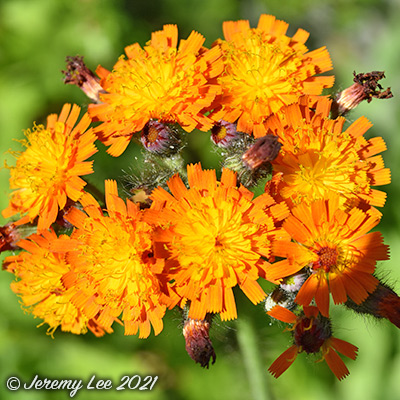
 |
|
Scientific Classifications explained » Amphibians » Ants » Aphids » Bees » Beetles » Birds » Bugs » Butterflies » Caterpillars » Damselflies » Dragonflies » Earwigs » Flies » Frog/Leafhoppers » Fungi » Galls » Grasshoppers » Harvestmen » Hoverflies » Lacewings » Ladybirds » Leaf Mines » Lichens » Mammals » Millipedes » Mosses » Moths » Sawflies » Slugs » Snails » Spiders » Trees & Shrubs » Wasps » Wild Flowers » Woodlice » Postboxes |
UK Nature > Wild Flowers > Yellow Wild Flowers > Pilosella aurantiaca

Scientific Name: Pilosella aurantiaca Common Name: Fox and Cubs Pilosella aurantiaca, more commonly known as Fox and Cubs, Orange Hawkbit, or Orange Hawkweed, is a member of the daisy family. It is a colourful perennial that spreads by seed and by means of stolons (runners) and shallow rhizomes. Plants usually grow to between 20 and 40cm in height, and the orange flowers are between 1 and 2.5cm in diameter. A key distinguishing feature (in addition to the orange colour of the flowers) is the presence of blackish hairs that cover the stems and, in particular, the young flower buds. At the base of each shallow-rooting plant is a rosette of hairy oval to lanceolate leaves from the centre of which the flower stem arises, bearing a tight cluster of up to 12 or occasionally more flowers on very short pedicels (stalks). Most common in central and southern Britain but also recorded in Ireland, Fox-and-cubs is an introduced invasive species not only in temperate parts of Europe and Asia but also in Australia, New Zealand, Tasmania and North America. Often found on stony waste land, in churchyards on roadside embankments and beside railway tracks, despite efforts to eradicate it this fast-spreading wildflower has also become a permanent feature of many parks and gardens. In Britain and Ireland Fox-and-cubs produces its first flowers in June, providing a welcome burst of colour after many of our native wildflowers have died back. Flowering continues through summer and autumn, usually at least until October. |
|

https://www.uknature.co.uk is a website dedicated to showing the immense diversity of UK nature and wildlife. Our vast range of habitats, from lowland arable to snow covered mountains, from storm-ravaged coastlines to peaceful inland freshwater lakes and rivers, from dry, sandy heaths to deciduous and coniferous forests, all these habitats contribute to the abundance of UK nature. We have wild birds in huge numbers either residing or visiting our shores (597 recorded species as at July 2013) and we must also not forget the humble back garden with its grass lawns, flower beds filled with nectar rich flowers, shrubs and trees, all designed to attract huge numbers of insects such as bees, moths, butterflies and hoverflies; and finally the small ponds which provide safe havens for frogs, toads, newts and even slow worms and grass snakes. www.uknature.co.uk is the showcase for my personal passion, photographing uknature in all its glory. I sincerely hope you all enjoy the fruits of my labours. This site and all images contained therein is © Jeremy Lee 2004 - 2025. All Rights Reserved. Site design by Jeremy Lee. Site development & IT Support by Stuart Lee. |